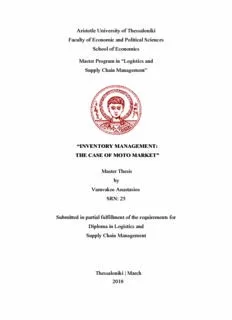Table Of ContentAristotle University of Thessaloniki
Faculty of Economic and Political Sciences
School of Economics
Master Program in “Logistics and
Supply Chain Management”
“INVENTORY MANAGEMENT:
THE CASE OF MOTO MARKET”
Master Thesis
by
Vamvakos Anastasios
SRN: 25
Submitted in partial fulfillm ent of the requirements for
Diploma in L ogistics and
Supply Chain Management
Thessaloniki | March
2018
Page intentionally left blank
Aristotle University of Thessaloniki
Faculty of Economic and Political Sciences
School of Economics
Master Program in “Logistics and
Supply Chain Management”
“INVENTORY MANAGEMENT:
THE CASE OF MOTO MARKET”
Master Thesis
by
Vamvakos Anastasios
SRN: 25
Submitted in partial fulfillment of the requirements for
Diploma in Logistics and
Supply Chain Management
Supervisor
Diamantidis Alexandros
Committee
Boutsouki Christina
Zikopoulos Christos
Thessaloniki | March
2018
© 2018
Vamvakos Anastasios
All Rights Reserved.
ACKNOWLDGEMENTS
Αt this point I would like to thank my supervisor, Diamantidis Alexandros, for our
constructive cooperation and his crucial contribution to my diplomatic work.
I would also like to thank my parents for their continuous support in all my efforts.
Finally, special thanks to Vamvakou Fotini and Papadopoulou Vasiliki for their
significant assistance in the completion of this project.
Vamvakos I. Anastasios
5
ABSTRACT
The object of this master thesis is to work out the theoretical and practical approach of
the most common problem that the majority of companies face, the inventory
management. In a business environment where multifarious constraints exist, either
internal or external, shaping the appropriate inventory policy is crucial. The aim is to
make a retrenchment of the inventory management by applying certain methods in
order to contribute to the proper decision-making of the collaborator company and the
inventory cost minimization. For this purpose, economic data of different codes of
products are used as a sample, firstly for an ABC Analysis formation in order to
prioritize items for inventory optimization and then, for the creation of an economic
model of a continuous review system with a fixed-order quantity and by setting a
certain level of safety stock and a point of order placement. The implementation of
the model comes to ascertain its effectiveness by comparing the new inventory cost
functions with the previous ones. Finally, the practical part of the thesis is completed
by making a forecast for the demand of 2018 for the same group of products by
applying the single exponential smoothing method so as to give an extra weight to the
most recent demand values.
Keywords: ABC Analysis, continuous review, economic order quantity, single
exponential smoothing, safety stock, reorder point.
6
CONTENTS
ACKNOWLDGEMENTS........................................................................................ 5
ABSTRACT.............................................................................................................. 6
CONTENTS.............................................................................................................. 7
LIST OF TABLES....................................................................................................10
LIST OF FIGURES..................................................................................................11
LIST OF GRAPHS...................................................................................................12
ABBREVIATIONS..................................................................................................13
1.Introduction....................................................................................................... 14
1.1 Background of the topic.............................................................................. 14
1.2Methodology............................................................................................... 15
1.3 Thesis outline.............................................................................................. 15
2. About Inventory................................................................................................ 17
2.1 Introduction to inventory............................................................................ 17
2.2 Historical data............................................................................................. 18
2.3 Inventory and Supply Chain Management................................................. 19
2.4 Inventory classification.............................................................................. 21
2.5 Cycle of inventory...................................................................................... 23
3. Literature Review............................................................................................. 24
3.1Inventory planning policy.......................................................................... 24
3.2Inventory costs........................................................................................... 26
3.3Service level............................................................................................... 28
3.4 Key performance indicators (KPIs) in inventory management ....................29
3.5Inventory review systems........................................................................... 30
3.5.1 Introduction....................................................................................... 30
3.5.2 Continuous review system................................................................ 31
3.5.3 Economic order quantity................................................................... 32
3.5.4 EOQ Assumptions............................................................................ 33
3.5.5 Costs calculation............................................................................... 34
3.5.6 Sensitivity of the EOQ...................................................................... 36
7
3.6Establishing Safety Stock Levels................................................................ 36
3.6.1 The Probability Approach................................................................. 36
3.6.2 Fixed –Order Quantity Model with Safety Stock............................ 37
3.6.3 Computing d, σ , and z...................................................................... 38
L
3.7 Common problems with inventory systems............................................... 40
4. ABC Analysis................................................................................................... 41
4.1 Introduction................................................................................................ 41
4.2 ABC Classification...................................................................................... 42
4.3 ABC Analysis steps..................................................................................... 45
5.Demand Forecasting......................................................................................... 45
5.1 Introduction................................................................................................ 45
5.2 Forecasting methods................................................................................... 46
5.2.1Qualitative methods............................................................................. 47
5.2.2Quantitative methods........................................................................... 48
5.3Independent -Dependent Demand.............................................................. 49
6.Information Systems & Inventory management........................................... 50
6.1 Introduction................................................................................................ 50
6.2 Inventory Information Management Systems............................................. 52
6.3 Material Requirements Planning Systems (MRP)..................................... 53
6.3.1 Material Requirements Planning Systems II.................................... 55
6.4Enterprise Resource Planning Systems (ERP)........................................... 55
7. The case of “Moto Market”............................................................................. 60
7.1 Company’s presentation............................................................................. 60
7.2 Facilities..................................................................................................... 61
7.3 Quality policy............................................................................................ 61
7.4 Human resources........................................................................................6..66.1
7.5 The concept..................................................................................................61
7.6 ABC Analysis.............................................................................................. 62
7.7 Continuous review implementation.............................................................766
7.7.1 Introduction.......................................................................................8...6.6
8
7.7.2 Calculation of the initial inventory cost............................................7.867
7.7.3 Model implementation...................................................................... 68
7.8 Demand Forecasting................................................................................... 74
8. Conclusions and Recommendations..............................................................376
Bibliography......................................................................................................... 78
APPENDICES........................................................................................................8.1
Appendix A – ABC Analyses..................................................................................8..2
Appendix B – Fixed-order quantity model ........................................................ 86
Appendix C - Forecast ..........................................................................................91
9
LIST OF TABLES
Table 1 Fixed–Order Quantity and Fixed–Time Period Differences……........... 31
Table 2 Inventory classification according to their value…………………........ 41
Table 3 Mean purchase value p e r i t e m & y e a r ……………………………........ 67
Table 4 Individual holding cos t p e r i t e m & y e a r …………………………........... 67
Table 5 Total holding cost per i t e m & y e a r ....……………………………......... 67
Table 6 Individual ordering cost per i t e m & y e a r …………………………......... 68
Table 7 Total ordering cost per item & year.....……………………………....... 68
Table 8 Total Inventory cost per item & year….....………………………......... 68
Table 9 EOQ per item & year…..............……………………..........……........... 69
Table 10 Total Inventory cost per item & year….......………………….…......... 69
Table 11 Total inventory cost comparison….....………………………….......... 70
Table 12 Safety stock levels per item & year ………………………….............. 73
for each corresponding service level
Table 13 Reorder point per item & year for each ………………..……...............73
corresponding service level
Table 14 Time between orders per item & year …………………………........... 74
Table 15 Number of orders per item & year……………………………….............74
10
Description:inventory cost minimization. For this purpose, economic data of different codes of products are used as a sample, firstly for an ABC Analysis formation in order to prioritize items for inventory optimization and then, for the creation of an economic model of a continuous review system with a fixed-

